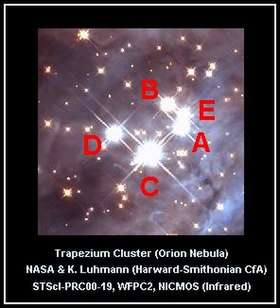오리온자리 세타1 A
Theta1 Orionis A| 관측 데이터 에폭 J2000 이쿼녹스 J2000 | |
|---|---|
| 별자리 | 오리온 |
| 우측 상승 | 05h 35m 15.84743s[1] |
| 탈위임 | −05° 23′ 14.3441″[1] |
| 겉보기 크기 (V) | 6.72 - 7.65[2] |
| 특성. | |
| 스펙트럼형 | B0.5V[3] |
| 변수형 | 알골[2] |
| 아스트로메트리 | |
| 고유 운동 (μ) | RA:4.81±0.10[4]mas/yr Dec.:−2.53±0.12[4]mas/yr |
| 시차 (π) | 2.626 ± 0.100[4] 마스 |
| 거리 | 1,240 ± 50 리 (380 ± 10 pc) |
| 절대치수 (MV) | −2.80[3] |
| 세부 사항 | |
| A1 | |
| 미사 | 15.3[3] M☉ |
| 반지름 | 4.5[3] R☉ |
| 루미도 | 16,200[3] L☉ |
| 표면 중력 (log g) | 4.30[3] cgs |
| 온도 | 30,700[3] K |
| 나이 | <2[3].5 마이어 |
| A3 | |
| 미사 | 2.5 - 2.7[5] M☉ |
| 반지름 | 6.4[5] R☉ |
| 세부 사항 | |
| A2 | |
| 미사 | 4[6] M☉ |
| 기타 지정 | |
| 데이터베이스 참조 | |
| 심바드 | 자료 |
세타 오리온자리1 A(Theta1 Orionis A)는 오리온자리에 있는 가변 3진성이다.겉보기 등급 범위는 6.72 - 7.65이며 기간은 65.432일이다.기절자 E는 물론 B, C, D와 함께 오리온의 트라페지움(The Trapezium)의 주연급 스타 중 하나이다.
변동성
③1 오리온자리 A는 밝기가 달라 65.432일마다 진도 6.72에서 7.65까지 떨어진다.이것들은 가까운 이항 쌍의 일식에 의해 발생한다.θ1 오리온자리 A는 변수별 명칭 V1016 오리온자리 V1016을 배정받았다.[2]
시스템
θ1 오리온자리 A는 3명의 멤버가 알려진 스타 시스템이다.성분 A1과 A2는 약 0.2 "로 분리되어 있는 반면, A1은 그 자체로 두 개의 별이 약 1 au로 분리된 분광형 이항이다.
θ1 오리온리스 A1은 에클립싱 이진법이나 2차 검출은 스펙트럼에서 하지 않고 1차보다 발광성이 훨씬 낮다.[5][9]2차 항성은 T 타우리 항성으로 제안되었으며, 아마도 스펙트럼 등급 A일 것이다.[10][9]궤도는 잘 정의되어 있지 않지만 기이한 것으로 보인다.[5]
θ1 오리온자리 A2는 A1과 0.2" 떨어져 있는 곳에 비해 약 1의 크기가 희미하다.이것은 90AU의 예상 분리에 해당한다.[10]두 별의 상대적인 움직임이 측정되었고 그들은 서서히 서로 가까워지고 있지만 궤도를 도출하는 것은 불가능했다.두 별의 상대적인 움직임은 단순히 직선이 될 수 있지만, 중력적으로 결합되어 있는 것으로 계산된다.[11]
참조
- ^ a b Kounkel, Marina; Hartmann, Lee; Loinard, Laurent; Mioduszewski, Amy J.; Dzib, Sergio A.; Ortiz-León, Gisela N.; Rodríguez, Luis F.; Pech, Gerardo; Rivera, Juana L.; Torres, Rosa M.; Boden, Andrew F.; Evans, Neal J.; Briceño, Cesar; Tobin, John (2014). "The Gould's Belt Very Large Array Survey. III. The Orion Region". The Astrophysical Journal. 790 (1): 49. arXiv:1406.1809. Bibcode:2014ApJ...790...49K. doi:10.1088/0004-637X/790/1/49. S2CID 119231061.
- ^ a b c Samus, N. N.; Durlevich, O. V.; et al. (2009). "VizieR Online Data Catalog: General Catalogue of Variable Stars (Samus+ 2007-2013)". VizieR On-line Data Catalog: B/GCVS. Originally Published in: 2009yCat....102025S. 1. Bibcode:2009yCat....102025S.
- ^ a b c d e f g h Nieva, María-Fernanda; Przybilla, Norbert (2014). "Fundamental properties of nearby single early B-type stars". Astronomy & Astrophysics. 566: A7. arXiv:1412.1418. Bibcode:2014A&A...566A...7N. doi:10.1051/0004-6361/201423373. S2CID 119227033.
- ^ a b c Kounkel, Marina; et al. (2017). "The Gould's Belt Distances Survey (GOBELINS) II. Distances and Structure toward the Orion Molecular Clouds". The Astrophysical Journal. 834 (2). 142. arXiv:1609.04041. Bibcode:2017ApJ...834..142K. doi:10.3847/1538-4357/834/2/142. S2CID 26439367.
- ^ a b c d Bossi, M.; Gaspani, A.; Scardia, M.; Tadini, M. (1989). "Orionis A - A pre-main sequence low Q binary system?". Astronomy and Astrophysics. 222: 117. Bibcode:1989A&A...222..117B.
- ^ Grellmann, R.; Preibisch, T.; Ratzka, T.; Kraus, S.; Helminiak, K. G.; Zinnecker, H. (2013). "The multiplicity of massive stars in the Orion Nebula Cluster as seen with long-baseline interferometry". Astronomy & Astrophysics. 550: A82. arXiv:1301.3045. Bibcode:2013A&A...550A..82G. doi:10.1051/0004-6361/201220192. S2CID 6554786.
- ^ "Download Data". aavso.org. AAVSO. Retrieved 1 October 2021.
- ^ Lloyd, C.; Stickland, D. J. (November 1999). "The Nature of the Bright Early-Type Eclipsing Binary Theta 1 Ori A = V1016 Orionis". Information Bulletin on Variable Stars. 4809. Retrieved 8 February 2022.
- ^ a b Vitrichenko, E. A.; Klochkova, V. G. (2000). "A Spectroscopic Study of V1016 Ori". Astronomy Letters. 26 (2): 104. Bibcode:2000AstL...26..104V. doi:10.1134/1.20373. S2CID 119402387.
- ^ a b Petr, Monika G.; Coudé Du Foresto, Vincent; Beckwith, Steven V. W.; Richichi, Andrea; McCaughrean, Mark J. (1998). "Binary Stars in the Orion Trapezium Cluster Core". The Astrophysical Journal. 500 (2): 825. Bibcode:1998ApJ...500..825P. doi:10.1086/305751.
- ^ Close, L. M.; Puglisi, A.; Males, J. R.; Arcidiacono, C.; Skemer, A.; Guerra, J. C.; Busoni, L.; Brusa, G.; Pinna, E.; Miller, D. L.; Riccardi, A.; McCarthy, D. W.; Xompero, M.; Kulesa, C.; Quiros-Pacheco, F.; Argomedo, J.; Brynnel, J.; Esposito, S.; Mannucci, F.; Boutsia, K.; Fini, L.; Thompson, D. J.; Hill, J. M.; Woodward, C. E.; Briguglio, R.; Rodigas, T. J.; Briguglio, R.; Stefanini, P.; Agapito, G.; et al. (2012). "High-resolution Images of Orbital Motion in the Orion Trapezium Cluster with the LBT AO System". The Astrophysical Journal. 749 (2): 180. arXiv:1203.2638. Bibcode:2012ApJ...749..180C. doi:10.1088/0004-637X/749/2/180. S2CID 119298839.
외부 링크
- "Trapezium (Theta1 Orionis)". The Worlds of David Darling. Retrieved 31 July 2014.
- "Theta-1 Orionis". Retrieved 31 July 2014.




